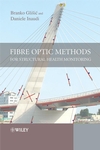Several Fraunhofer institutes and various industrial partners are currently working on an SHM system that will use ultrasound to detect any damage to the technical structures of aircraft, pipelines or wind turbines. The core of the sensors used is made up of ceramic piezo fibers that convert mechanical energy into electrical impulses and vice-versa. Any piezo element can be used as either a transmitter or a receiver. It can excite the structure to produce vibrations, and it can record vibrations in the structure.
The ultrasound waves spread out in certain patterns depending on the type of structure. Cracks and other flaws alter this wave pattern in the same way as a rock changes the pattern of waves in a lake. Even a group of four piezo elements is sufficient to locate flaws accurately to the nearest centimeter – flaws that are often no more than a few millimeters in size.
“Our system is intended to supplement the checks used up to now,” says Bernhard Brunner of the Fraunhofer Institute for Silicate Research ISC, Würzburg. But that is only the first step. If the SHM systems prove successful, the researchers can envisage a status-dependent maintenance and repair system: “to save inspections and therefore time,” adds Brunner’s project partner Bernd Frankenstein of the Fraunhofer Institute for Non-Destructive Testing IZFP in Dresden. He is in no doubt that SHM systems will eventually replace conventional test methods, at least in part. The task of the Fraunhofer Institute for Structural Durability and System Reliability LBF is to create deliberate flaws in structures, which can then be detected during tests.
There are even more reasons for teaching structures to ‘feel’. It helps to make better use of valuable resources, both materials and energy. This is particularly noticeable in the aviation industry, where each gram less in the weight of the aircraft increases its potential payload as well as reducing exhaust fumes.
Continuous monitoring by SHM systems is also expected to yield greater safety, particularly for equipment such as offshore wind farms that are not readily accessible. The artificial nervous system fulfills a dual task in such cases: It monitors the structure and at the same time delivers data about occurrences in the structure during day-to-day operation. Data of this kind, which hardly existed until now, will help to optimize the next generations of components.
[Fraunhofer-Gesellschaft via physorg.com]
Thursday, April 10, 2008
Subscribe to:
Post Comments (Atom)




No comments:
Post a Comment